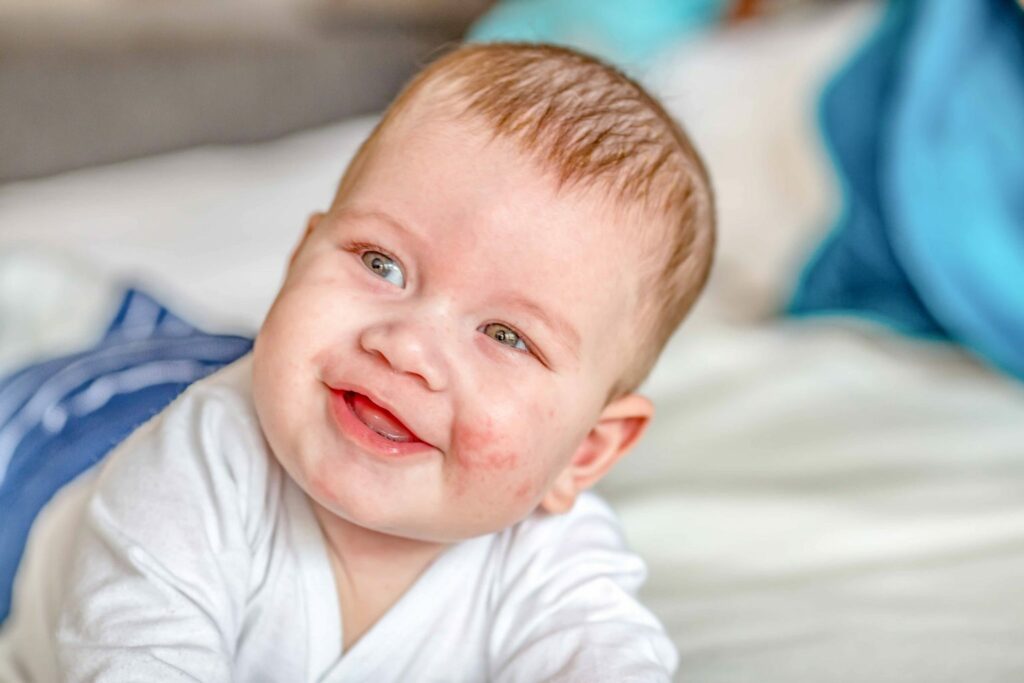There are few things worse than seeing your baby struggle with bright red cheeks, oozing wounds, and scratching themself bloody. Watching their skin flake off and leave piles where they sat is horrible. The sleepless nights and tortured cries are gut-wrenching.
As a parent and a clinician that sees this on a weekly basis, my heart goes out to the parents who are watching their little ones suffer. I’ve been there myself having had eczema and with little ones that had it too, so I can relate to the experience of the parents and the kiddos suffering through it.
Thankfully, you can solve the eczema puzzle with the right steps. The key is identifying the underlying root causes and treating them appropriately.
In adults, the underlying causes are many ranging from genetic predispositions, stress/trauma, and toxicity, to dietary factors, hormone and nutrient imbalances, and a disrupted microbiome- especially in the gut. Inflammatory conditions like eczema arise when the environmental factors mentioned collide with genetics (dig deeper into this subject in another article I wrote).
The GREAT news is that eczema in little ones is much easier to resolve since they don’t have decades of stress, trauma, and environmental exposures that make it trickier in adults! Plus, their little bodies have an incredible capacity to heal.
Taking a Thorough History to learn more about your baby’s eczema
The first step in this process is taking a thorough history to uncover predisposing factors. Some of the issues we commonly see in little ones with eczema are:
- C-section birth or birth complications/ interventions
- Mom had Group B Strep, UTI, or yeast infection during pregnancy
- Stress for Mom during pregnancy
- Mom having known GI issues that were not resolved prior to pregnancy.
- Family history of the allergic triad (allergies, asthma, and eczema),
- Nursing or feeding troubles, colic, or early food allergies (rejection of solids or food avoidance can be a sign something is off with the gut)
- Seasonal skin flares indicating an allergic component
- History of mother or baby living in a moldy environment or near high chemical or pollutant concentrations such as farms, golf courses, airports, highways, industry, etc.
- Baby or child having constipation, diarrhea or loose stools, gas, burping or bloating
Having a thorough history allows us to see the big picture of what the likely causes are and what tests we need to order. I always order a comprehensive stool analysis so gut imbalances like dysbiosis can be identified, as well as the bacteria, fungi, and parasites that may be causing it. GI health markers are also helpful in determining inflammation, immune activation, and digestive function.
Additional Testing for an accurate diagnosis and treatment
Additional testing is sometimes necessary and could involve:
- serum labs to assess the immune system or allergens
- organic acids to assess fungi/mold and harmful bacteria
- food allergy or sensitivity testing or other specialized testing
- we can also do genetic analysis if the child or parent has completed a 23andMe.
Regarding testing, it’s important to note that you should wait until you see a qualified provider to decide which tests are needed. If you order them on your own, you may order the wrong ones and end up having to spend extra money unnecessarily on the right ones. In my practice, the only tests we order are ones that directly inform the course of treatment.
Once the test results are received and reviewed, a treatment plan specific to the needs of the patient is made. The bulk of treatment in little ones is generally focused on balancing the immune system, replacing nutrients, and supporting proper gut and digestive function.
Skin healing typically begins during the first 1-2 months and is often almost resolved by 3-4 months. Total treatment time for babies is generally around 4-6 months total and sometimes a little longer in older children.
Our goal is not only for your child to find relief and have soft, smooth skin, but also to give parents the tools to support their kiddos if skin issues crop up again.
Dr. Stephanie Davis

